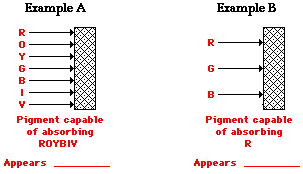
We have previously learned that visible light waves consist of a continuous range of wavelengths or frequencies. When a light wave with a single frequency strikes an object, a number of things could happen. The light wave could be absorbed by the object, in which case its energy is converted to heat. The light wave could be reflected by the object. And the light wave could be transmitted by the object. Rarely however does just a single frequency of light strike an object.

The Record of Transmitting the Light: Zen Master Keizan's Denkoroku [Francis Dojun Cook, Francis H. Cook] on Amazon.com. *FREE* shipping on qualifying ..
Attributed to the thirteenth-century Zen Master Keizan (1268-1325), Transmission of Light (along with The Blue Cliff Record and The Gateless Barrier) is one of ..
Visible light is the reason we are able to see anything at all. Light moves as a wave, bouncing off objects so we can see them. Without it, we would be in complete darkness. But in physics, light can refer to any kind of electromagnetic wave: radio waves, microwaves, infrared, visible light, ultraviolet, x-rays or gamma rays. When you shine light on an object, a number of things can happen. One thing it can do bounce off the surface, and this is called reflection. When light reflects off a shiny surface like a mirror, this is called specular reflection, but when it just illuminates a dull object this is called diffuse reflection. Another thing it can do is move (or 'transmit') through the material, and depending on exactly how it does this, we might call it transmission, refraction, or absorption. We will discuss each in more detail in this lesson, but transmission of light is when light waves move all the way through a material without being absorbed. Transmittance When light moves through a transparent (or semi-transparent) material, it can be transmitted, absorbed or reflected. The transmittance of a material is the proportion of the incident (approaching) light that moves all the way through to the other side. For example, let's say you're shining a flashlight on a semi-transparent glass block. You start off with 100% of your incident light. The first thing that happens is that 30% of that light is reflected off the outer surface of the glass. That leaves you with 70% to continue through the glass block. Another 50% of the light is absorbed by the molecules inside the glass block itself. That leaves you with 20% that immerges from the opposite side. So you could say that the glass block has a transmittance of 20%. The transmittance of a material depends on its thickness, but it also depends on the type of 'light' (or electromagnetic waves) you are using. A material might have a different transmittance for visible light than it does for infrared, or x-rays. This is why hospital x-rays go through your skin until they reach the bones, even though visible light does not. Lesson Summary Transmission of light is the moving of electromagnetic waves (whether visible light, radio waves, ultraviolet etc.) through a material. This transmission can be reduced or stopped when light is reflected off the surface, or absorbed by the molecules in the material. Transmission of light is measured by looking at the percentage of incident (approaching) light that makes it all the way through a material. This is called the transmittance, and is different depending on what the material is made from, how thick the material is, and what kind of electromagnetic waves are being used. If you shine a light at 90 degrees to the surface of a medium (material), the term transmission is always used. But when you shine a light at another angle, the beam of light will bend. In this case, the light is said to have 'refracted'. Understanding the transmission of light, or in general how light interacts with different materials is an important part of fully appreciating how our universe works. This understanding enables us to design eyeglasses, windows (clear and frosted) and to appreciate how we can penetrate surfaces using waves of different kinds, such as how x-rays in a hospital penetrate the outer tissues. This understanding helps us build our homes, improve people's sight and save lives. To unlock this lesson you must be a Study.com Member. Create your account

LIGHT PROPERTIES. Absorption, reflection and transmission. When light reaches an object, different things can happen: Light can be absorbed, reflected or ..

For transmission through a surface, see Fresnel equations. Diagram of Beer-Lambert Law of transmittance of a beam of light as it travels through a cuvette of ..

This lesson will explain what is meant by ''transmission of light'', discuss the ways that light can be transmitted through a medium, and how it is..